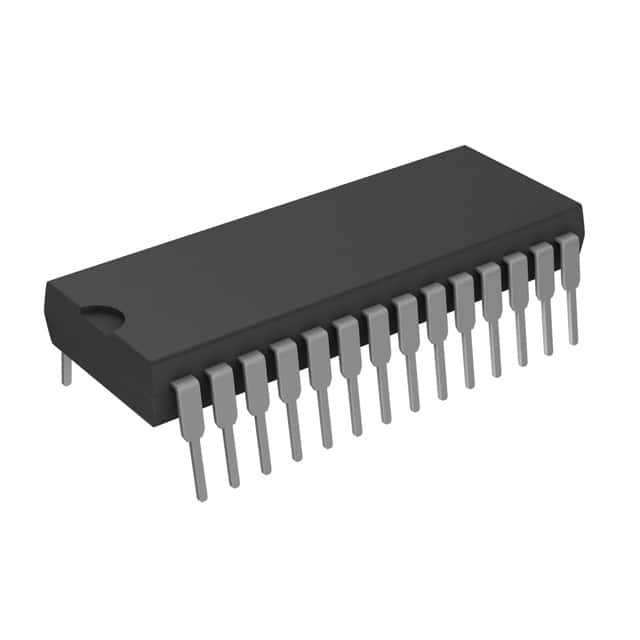AT28BV64-30PC
Product Overview
Category
AT28BV64-30PC belongs to the category of non-volatile memory devices.
Use
This product is primarily used for storing and retrieving digital information in electronic systems.
Characteristics
- Non-volatile: The stored data remains intact even when power is removed.
- High capacity: The AT28BV64-30PC has a storage capacity of 64 kilobits (8 kilobytes).
- Low power consumption: It operates at low power levels, making it suitable for battery-powered devices.
- Fast access time: The device offers quick access to stored data.
Package
The AT28BV64-30PC is available in a 32-pin PDIP (Plastic Dual In-line Package) format.
Essence
The essence of this product lies in its ability to provide reliable and non-volatile storage for electronic systems.
Packaging/Quantity
The AT28BV64-30PC is typically packaged in tubes or trays, with each package containing a specific quantity of devices. The exact quantity may vary depending on the supplier.
Specifications
- Memory Type: EEPROM (Electrically Erasable Programmable Read-Only Memory)
- Organization: 8K x 8 bits
- Supply Voltage: 2.7V - 3.6V
- Access Time: 30ns
- Operating Temperature Range: -40°C to +85°C
- Data Retention: 10 years
Detailed Pin Configuration
The AT28BV64-30PC features a total of 32 pins, each serving a specific purpose. The pin configuration is as follows:
- A0 - Address Input
- A1 - Address Input
- A2 - Address Input
- A3 - Address Input
- A4 - Address Input
- A5 - Address Input
- A6 - Address Input
- A7 - Address Input
- VCC - Power Supply
- OE - Output Enable
- CE - Chip Enable
- WE - Write Enable
- I/O0 - Data Input/Output
- I/O1 - Data Input/Output
- I/O2 - Data Input/Output
- I/O3 - Data Input/Output
- I/O4 - Data Input/Output
- I/O5 - Data Input/Output
- I/O6 - Data Input/Output
- I/O7 - Data Input/Output
- NC - No Connection
- NC - No Connection
- NC - No Connection
- GND - Ground
- NC - No Connection
- NC - No Connection
- NC - No Connection
- NC - No Connection
- NC - No Connection
- NC - No Connection
- NC - No Connection
- NC - No Connection
Functional Features
- Byte-wise Read and Write: The AT28BV64-30PC allows individual bytes to be read from or written to, providing flexibility in data manipulation.
- In-System Programmable: The device can be programmed while it is connected to the system, eliminating the need for removal and reprogramming.
- Software and Hardware Data Protection: The AT28BV64-30PC offers various mechanisms to protect stored data from accidental modification or unauthorized access.
Advantages and Disadvantages
Advantages
- Non-volatile storage ensures data integrity even during power loss.
- High storage capacity for a wide range of applications.
- Low power consumption extends battery life in portable devices.
- Fast access time enables quick retrieval of data.
Disadvantages
- Limited storage capacity compared to other memory technologies.
- Relatively slower write speeds compared to volatile memory devices.
Working Principles
The AT28BV64-30PC utilizes EEPROM technology, which allows for electrically erasing and reprogramming of data. It consists of a grid of memory cells that can be individually addressed for reading or writing operations. The device uses a combination of voltage levels and control signals to perform these operations accurately and reliably.
Detailed Application Field Plans
The AT28BV64-30PC finds applications in various electronic systems, including but not limited to: - Embedded systems - Consumer electronics - Automotive electronics - Industrial control systems - Communication devices
Detailed and Complete Alternative Models
- AT28C64B-15PU: Similar specifications with a different package (DIP)
- AT28HC64B-12PU: Higher endurance version with faster access time
- AT28BV64B-20PU: Lower power consumption variant with extended temperature range
These alternative models offer similar functionality and compatibility with the AT28BV64-30PC, providing options based on specific requirements.
In conclusion, the AT28BV64-30PC is a
Lista 10 Vanliga frågor och svar relaterade till tillämpningen av AT28BV64-30PC i tekniska lösningar
Sure! Here are 10 common questions and answers related to the application of AT28BV64-30PC in technical solutions:
Q: What is the AT28BV64-30PC? A: The AT28BV64-30PC is a 64K (8K x 8) Parallel EEPROM (Electrically Erasable Programmable Read-Only Memory) chip.
Q: What is the operating voltage range for the AT28BV64-30PC? A: The AT28BV64-30PC operates within a voltage range of 4.5V to 5.5V.
Q: How much data can the AT28BV64-30PC store? A: The AT28BV64-30PC can store up to 64 kilobits (8 kilobytes) of data.
Q: What is the access time of the AT28BV64-30PC? A: The AT28BV64-30PC has an access time of 30 nanoseconds.
Q: Can the AT28BV64-30PC be reprogrammed? A: Yes, the AT28BV64-30PC is electrically erasable and programmable, allowing it to be reprogrammed multiple times.
Q: What is the package type of the AT28BV64-30PC? A: The AT28BV64-30PC comes in a 32-lead PDIP (Plastic Dual In-Line Package).
Q: What is the endurance rating of the AT28BV64-30PC? A: The AT28BV64-30PC has an endurance rating of at least 100,000 erase/write cycles.
Q: Does the AT28BV64-30PC require an external power supply? A: Yes, the AT28BV64-30PC requires an external power supply within the specified voltage range.
Q: Can the AT28BV64-30PC operate in harsh environments? A: The AT28BV64-30PC is not specifically designed for harsh environments and may require additional protection if used in such conditions.
Q: What are some typical applications of the AT28BV64-30PC? A: The AT28BV64-30PC is commonly used in various technical solutions, including embedded systems, industrial control systems, automotive electronics, and consumer electronics.
Please note that these answers are general and may vary depending on specific requirements and use cases.


